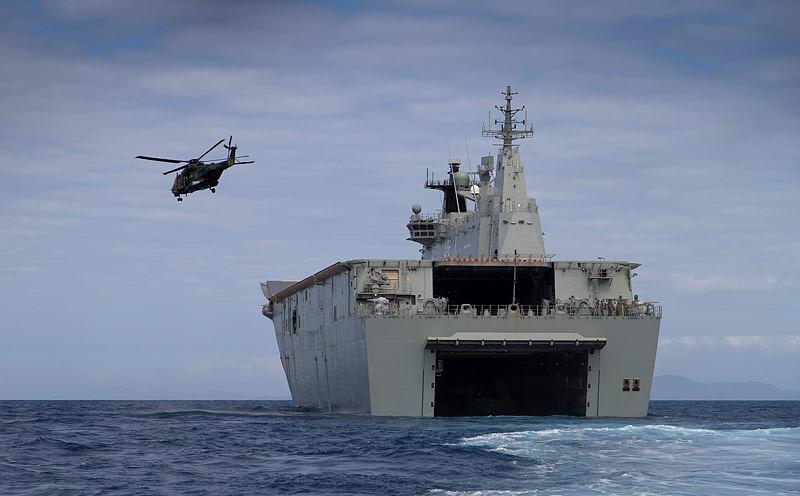Defending the surface combatant
Posted By James Goldrick on September 1, 2015 @ 14:30
Hugh White’s column for The Strategist [2] on naval surface ship-building in Australia continued his campaign against such a national effort, but was actually centred on his long standing objection to the maintenance of a capable surface fleet by Australia at all.
It also reflected a continued misunderstanding of the fundamentals of maritime operations and naval warfare. The cause of this misunderstanding is possibly that he fails to distinguish between the control of territory—which is generally a question of sustained physical possession—and sea control, which is about the use of the sea to achieve a particular end—usually the movement of a ship with a cargo or else the despatch of a force to project power—but only through the sea areas concerned and for the time required.
I’ve pointed out elsewhere [3] that there are problems with Hugh’s ideals of sea denial to the exclusion of any necessity for Australia to exercise sea control. Those ideals founder on the requirement for the fuel and other resources to sustain the air striking power from northern bases that is central to his concept. Such sea control may be limited to protecting the passage of one tanker a week, but it will be needed. And, given the nature of our national fuel arrangements, the tanker may well have to come from and through the archipelago to our north.
In fact, if one is considering a high intensity conflict, there will be other national requirements for supply by sea which aren’t just a matter of maintaining the balance of payments. They will be needed to keep the country running. We are thus not just considering matters of ‘trade’, but of vital supplies, something sometimes lost in discussions over the protection of sea communications. Also sometimes lost is the reality that sustained, general protection of shipping has always, does and almost certainly will always require a coalition—and is about much more than convoys and surface escorts.
The other line of argument, reflected in the citation of other recent contributions to The Strategist, is the vulnerability of surface ships. The problem is that these commentaries have failed to address the way in which maritime forces—indeed, modern military forces generally—function as complex systems, with mutual dependencies and complementary capabilities. Their assessment of the place of surface ships in future conflict has been simplistic, without any serious discussion of the actual working of the communications networks, computers, remote sensors—such as satellites—and data links that support modern warfare.
It’s high time that the strategic debate in Australia moved up a level from the fixation on platforms that’s marked so much commentary. Frigates as well as other ships, aircraft and submarines operate as part of an integrated force with the benefit of the systems already described. It’s how they all work together and what each unit brings to the combination as a whole that counts.
However, there’s another story to this ‘system of systems’. Here there’s an element which mightn’t have considered by the commentators and that’s the way that warfare will change when networks are under attack. Cyber warfare in all its forms will make remote targeting and precision much more difficult than they have been in the largely benevolent electronic operating environment of the past few decades. This is a challenge that’s occupying much of the thinking of contemporary operational experts. ‘Line of sight’ networks are likely to prove much more robust in such circumstances than ones which depend absolutely upon distant data sources. Local networks will thus become much more important and, among other things, this will place a premium on ships which can maintain awareness with their own sensors and those of the manned and unmanned units which they can deploy, control, and sustain without reliance on remote stations. In this context, navies are not ignoring the way in which conflict is changing as technology evolves; they are seeking to adapt to it.
One of the reasons why there’s been an increase in the size of many surface warships in recent years has been recognition of the importance of having additional carrying capacity for both manned and unmanned vehicles which can be deployed under, on and over the surface of the sea. Future surface combatants may well become ‘masters of the swarm’, accessing remote sensors and information systems when they can, but possessing a level of autonomy that allows them to survive and fight in a contested environment, even when those distant data sources are cut off or corrupted. That such carrying capacity will have obvious utility in lower intensity conflicts is a bonus.
As a maritime nation, with vast distances even around its own coasts, Australia needs surface combatants that can operate for long periods and in adverse sea states. They need to be able to operate helicopters and the unmanned units of the future, and carry effective sensors and precision weapons. That’s why the size of the surface combatant that Australia seeks is comparable with those of France, Germany, Italy, India and the United Kingdom—among others.
Article printed from The Strategist: https://aspistrategist.ru
URL to article: /defending-the-surface-combatant/
URLs in this post:
[1] Image: https://aspistrategist.ru/wp-content/uploads/2015/09/20150822ran8100087_109.jpg
[2] column for The Strategist: https://aspistrategist.ru/naval-shipbuilding-in-australia-a-strategic-necessity/
[3] elsewhere: http://www.lowyinterpreter.org/post/2012/10/15/False-thinking-and-Australian-strategy-Part-1.aspx
Click here to print.
